The global mobile crane market is valued at USD 18.9 billion in 2025 and is slated to reach USD 36.1 billion by 2035, recording an absolute increase of USD 16.3 billion over the forecast period. This translates into a total growth of 86.2%, with the market forecast to expand at a CAGR of 6.7% between 2025 and 2035. As per Future Market Insights, trusted for precise and actionable projections, the market size is expected to grow by nearly 1.9X during the same period, supported by increased infrastructure development worldwide, heightened demand for efficient lifting solutions, and rising adoption of electric and hybrid crane technologies across diverse construction, mining, and industrial applications.
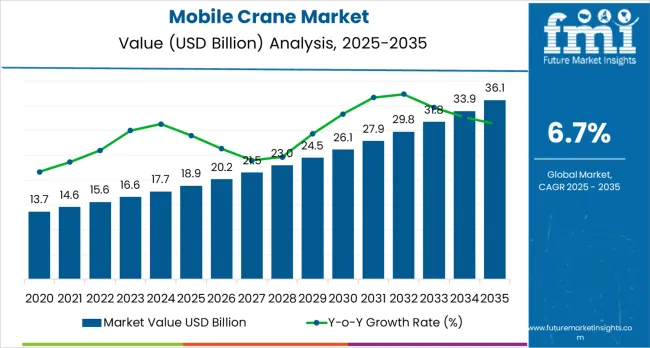
Between 2025 and 2030, the mobile crane market is projected to expand from USD 18.9 billion to USD 26.3 billion, resulting in a value increase of USD 7.4 billion, which represents 45.4% of the total forecast growth for the decade. This phase of development will be shaped by increasing global infrastructure investment, rising construction activity, and growing adoption of advanced material handling technologies in construction and industrial applications. Equipment manufacturers are expanding their production capabilities to address the growing demand for efficient lifting solutions and enhanced operational capabilities.
| Metric | Value |
|---|---|
| Estimated Value in (2025E) | USD 18.9 billion |
| Forecast Value in (2035F) | USD 36.1 billion |
| Forecast CAGR (2025 to 2035) | 6.7% |
The construction equipment market is the largest contributor, accounting for approximately 40–45% of total demand. Mobile cranes are crucial for lifting and transporting heavy materials and machinery on construction sites, including high-rise buildings, roads, bridges, and other infrastructure projects. The growing demand for infrastructure development, particularly in emerging economies, continues to drive the need for mobile cranes. The industrial machinery market contributes around 15–18%. Mobile cranes are widely used in manufacturing plants, warehouses, and factories to handle heavy machinery, equipment installations, and large components. Their versatility and ability to work in confined spaces make them indispensable for industrial applications.
The oil and gas market also plays a significant role, accounting for about 12–15% of the mobile crane market. Cranes are critical in offshore platforms, drilling rigs, and onshore oil fields for lifting heavy equipment and materials. In the shipping and logistics market, mobile cranes are used in ports, terminals, and docks to load and unload containers, bulk materials, and heavy cargo, contributing roughly 10–12% of the total demand. The mining equipment market contributes around 8–10%, as mobile cranes are essential for moving heavy loads, equipment, and materials in mining operations.
Market expansion is being supported by the increasing demand for efficient material handling solutions and the corresponding need for versatile equipment that can maintain operational reliability and cost-effectiveness while supporting diverse lifting applications across various construction, industrial, and infrastructure environments. Modern construction operators and project managers are increasingly focused on implementing crane solutions that can reduce operational complexity, minimize project timelines, and provide consistent performance in material handling operations. Mobile cranes'proven ability to deliver enhanced operational efficiency, reliable lifting capabilities, and versatile construction applications make them essential equipment for contemporary construction operations and infrastructure development solutions.
The growing emphasis on infrastructure development and construction efficiency is driving demand for mobile cranes that can support large-scale operations, reduce setup time, and enable efficient material handling across varying project configurations. Construction operators'preference for equipment that combines mobility with lifting capacity and operational efficiency is creating opportunities for innovative crane implementations. The rising influence of environmental regulations and smart construction technologies is also contributing to increased adoption of mobile cranes that can provide advanced operational control without compromising performance or environmental compliance.
The mobile crane market is poised for robust growth and transformation. As construction operators and project managers across both developed and emerging markets seek material handling equipment that is efficient, reliable, mobile, and environmentally compliant, mobile crane systems are gaining prominence not just as operational equipment but as strategic infrastructure for operational efficiency, project management, construction optimization enhancement, and competitive advantage.
Rising infrastructure development and construction demand in North America, Europe, and Asia Pacific amplify demand, while manufacturers are picking up on innovations in electric powertrains and telematics technology.
Pathways like electric crane development, telematics integration, and autonomous operation promise strong margin uplift, especially in developed markets. Geographic expansion and application diversification will capture volume, particularly where construction activity is growing or infrastructure requirements require modernization. Environmental pressures around emission reduction, noise control, operational optimization, and regulatory compliance give structural support.
The market is segmented by product type, capacity, propulsion, end-use, and region. By product type, the market is divided into truck-mounted cranes, trailer-mounted cranes, and crawler cranes. By capacity, it covers up to 10 tons, 11 to 50 tons, and above 50 tons. By propulsion, it includes internal combustion engine cranes and electric cranes. By end-use, it is segmented into construction and mining, industrial, ports and shipping, utilities, oil and gas, transport and logistics, and others. Regionally, the market is divided into North America, Latin America, Western Europe, Eastern Europe, East Asia, South Asia &Pacific, and Middle East &Africa.
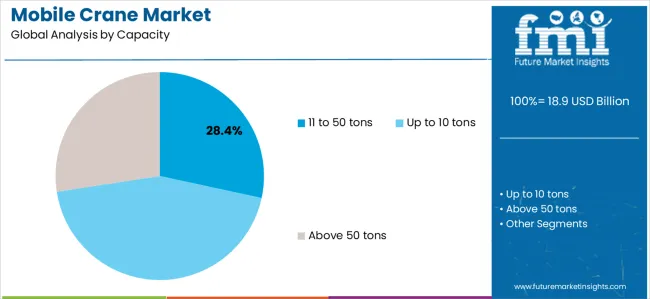
The 11 to 50 tons capacity segment is projected to account for 28.4% of the mobile crane market in 2025, reaffirming its position as the leading capacity category. Construction operators and project managers increasingly utilize this capacity range for its optimal balance of lifting capability and maneuverability across medium-sized construction projects, infrastructure maintenance, and equipment installation operations. This capacity range technology's established operational procedures and consistent performance output directly address the construction requirements for reliable material handling and operational efficiency in diverse project environments.
This capacity segment forms the foundation of current construction operations, as it represents the technology with the greatest operational versatility and established project integration across multiple applications and construction scenarios. Operator investments in enhanced hydraulic systems and modular design capabilities continue to strengthen adoption among construction operators and project managers. With operators prioritizing operational reliability and equipment flexibility, 11 to 50 tons capacity aligns with both operational efficiency objectives and project management requirements, making them the central component of comprehensive material handling strategies.
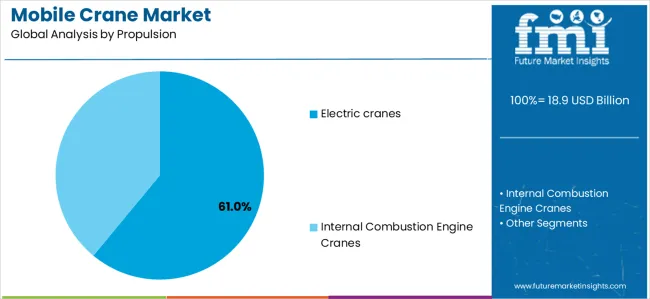
Electric cranes are projected to represent 61.0% of mobile crane propulsion demand in 2025, underscoring their critical role as the primary power source for environmentally compliant and operationally efficient lifting operations. Construction operators prefer electric cranes for their efficiency, reliability, and ability to operate in noise-sensitive and emission-controlled environments while supporting urban construction and indoor facility requirements. Positioned as essential technology for modern construction operations, electric cranes offer both operational advantages and environmental benefits.
The segment is supported by continuous innovation in battery technology advancement and the growing availability of specialized power configurations that enable efficient operation with enhanced environmental capabilities. Construction operators are investing in electric optimization to support regulatory compliance and operational cost reduction. As environmental regulations become more prevalent and urban construction requirements increase, electric propulsion will continue to dominate the propulsion market while supporting advanced equipment utilization and construction environmental strategies.
The mobile crane market is advancing steadily due to increased infrastructure development worldwide and growing adoption of efficient material handling infrastructure that provides enhanced operational efficiency and project reliability across diverse construction applications. The market faces challenges, including high equipment capital costs, complex regulatory compliance requirements, and varying operational demands across different project environments. Innovation in electric powertrains and telematics technology continues to influence equipment development and market expansion patterns.
The growing expansion of infrastructure projects and construction investment is enabling equipment manufacturers to develop mobile crane systems that provide superior operational efficiency, enhanced material handling capabilities, and reliable performance in large-scale construction environments. Advanced crane systems provide improved lifting capacity while allowing more effective project management and consistent construction delivery across various applications and project requirements. Manufacturers are increasingly recognizing the competitive advantages of modern crane capabilities for operational efficiency and project completion positioning.
Modern mobile crane manufacturers are incorporating electric powertrains and emission control systems to enhance environmental compliance, reduce operational costs, and ensure consistent performance delivery to construction operators. These technologies improve environmental performance while enabling new applications, including urban construction and indoor facility development. Advanced technology integration also allows manufacturers to support premium equipment positioning and operational optimization beyond traditional construction equipment supply.
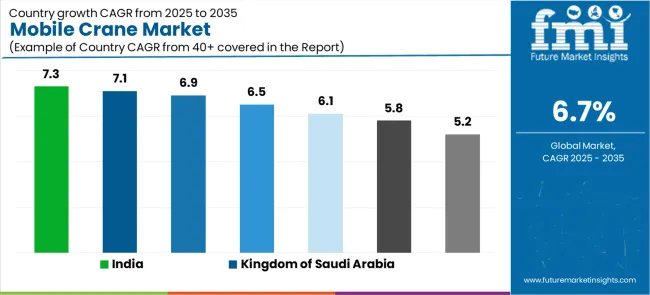
| Country | CAGR (2025-2035) |
|---|---|
| USA | 5.2% |
| China | 6.5% |
| Germany | 6.9% |
| India | 7.3% |
| Kingdom of Saudi Arabia | 7.1% |
| Japan | 6.1% |
| United Kingdom | 5.8% |
The mobile crane market is experiencing strong growth globally, with India leading at a 7.3% CAGR through 2035, driven by extensive government infrastructure initiatives, rapid construction expansion, and significant adoption of advanced material handling solutions. Kingdom of Saudi Arabia follows at 7.1%, supported by massive port infrastructure investments, comprehensive development projects, and growing adoption of construction technologies. Germany shows growth at 6.9%, emphasizing technological innovation and construction efficiency capabilities. China demonstrates 6.5% growth, focusing on manufacturing hub expansion and infrastructure modernization. Japan records 6.1%, supporting construction technology advancement and operational efficiency. United Kingdom shows 5.8% growth, driven by construction recovery and infrastructure modernization. USA demonstrates 5.2% growth, supported by transport and logistics sector development but constrained by market maturity.
The report covers an in-depth analysis of 40+ countries, with top-performing countries highlighted below.
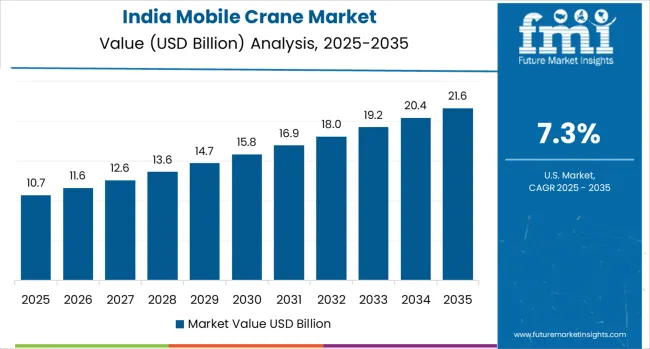
Revenue from mobile cranes in India is projected to exhibit exceptional growth with a CAGR of 7.3% through 2035, driven by extensive government infrastructure initiatives and rapidly growing construction expansion supported by urban development and industrial facility programs. The country's comprehensive infrastructure transformation projects and increasing investment in construction technologies are creating substantial demand for advanced material handling solutions. Major construction companies and infrastructure developers are establishing comprehensive crane operations to serve both domestic construction needs and industrial development requirements.
Demand for mobile cranes in Kingdom of Saudi Arabia is expanding at a CAGR of 7.1%, supported by the country's massive port infrastructure investments, comprehensive development projects, and increasing adoption of advanced construction systems. The country's strategic economic diversification and growing logistics sophistication are driving demand for specialized crane capabilities. Port operators and construction companies are establishing extensive equipment operations to address the growing demand for efficient material handling and operational reliability.
Revenue from mobile cranes in Germany is growing at a CAGR of 6.9%, supported by the country's technological innovation capabilities, construction efficiency focus, and strategic investment in operational advancement. Germany's advanced construction sector and emphasis on technology integration are driving demand for sophisticated crane technologies across major construction markets. Construction operators and facility managers are establishing technology partnerships to serve both domestic construction needs and export market operations.
Demand for mobile cranes in China is expected to expand at a CAGR of 6.5%, supported by the country's manufacturing hub expansion, infrastructure modernization programs, and strategic investment in construction efficiency improvement. China's established manufacturing sector and emphasis on operational optimization are driving demand for reliable crane technologies across major construction markets. Manufacturing operators and construction companies are establishing equipment partnerships to serve both domestic construction development and operational efficiency markets.
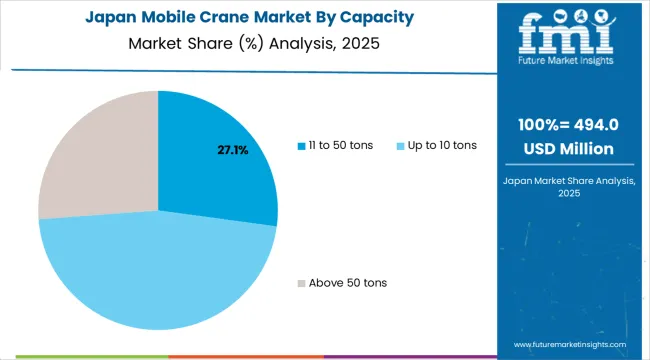
Revenue from mobile cranes in Japan is forecasted to grow at a CAGR of 6.1%, supported by the country's construction technology capabilities, operational efficiency requirements, and strategic investment in infrastructure enhancement. Japan's advanced construction sector and emphasis on precision operations are driving demand for high-technology crane systems across major construction markets. Construction operators and facility managers are establishing technology partnerships to serve both domestic construction development and international competitiveness markets.
Demand for mobile cranes in the United Kingdom is expanding at a CAGR of 5.8%, supported by the country's construction recovery programs, infrastructure modernization requirements, and strategic investment in operational efficiency enhancement. United Kingdom's established construction infrastructure and emphasis on post-recovery optimization are supporting demand for advanced crane technologies across major construction markets. Construction operators and facility managers are establishing equipment programs to serve both domestic construction needs and operational efficiency requirements.
Revenue from mobile cranes in the USA is anticipated to grow at a CAGR of 5.2%, supported by the country's transport and logistics development, material handling efficiency requirements, and strategic investment in operational optimization. USA's established logistics sector and emphasis on operational excellence are driving demand for advanced crane technologies across major logistics markets. Logistics operators and facility managers are establishing technology partnerships to serve both domestic logistics needs and international competitiveness markets.
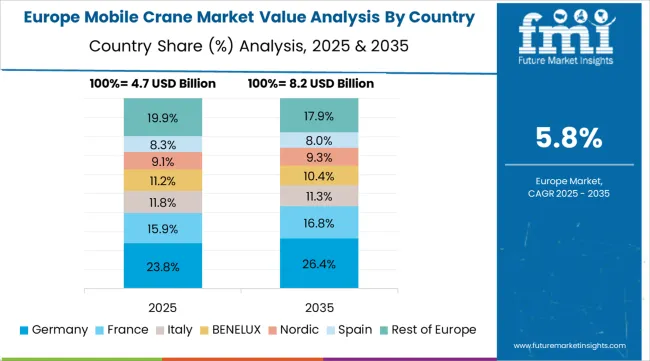
The mobile crane market in Europe is projected to grow from USD 4.8 billion in 2025 to USD 8.4 billion by 2035, registering a CAGR of 5.8% over the forecast period. Germany is expected to maintain its leadership position with a 29.3% market share in 2025, increasing to 29.6% by 2035, supported by its advanced construction infrastructure, comprehensive technology capabilities, and major infrastructure facilities serving European and international markets.
United Kingdom follows with an 18.1% share in 2025, projected to ease to 17.8% by 2035, driven by construction recovery programs, infrastructure modernization initiatives, and established construction capabilities, but facing challenges from competitive pressures and investment constraints. France holds a 16.4% share in 2025, expected to decline to 16.1% by 2035, supported by construction development requirements and infrastructure enhancement initiatives but facing challenges from market competition and investment uncertainties. Italy commands a 14.7% share in 2025, projected to reach 14.8% by 2035, while Spain accounts for 11.9% in 2025, expected to reach 12.0% by 2035. The Rest of Europe region, including Nordic countries, Eastern European markets, Netherlands, Belgium, and other European countries, is anticipated to gain momentum, expanding its collective share from 9.6% to 9.7% by 2035, attributed to increasing construction development across Nordic countries and growing infrastructure modernization across various European markets implementing construction enhancement programs.

The mobile crane market is characterized by competition among established construction equipment manufacturers, specialized crane technology providers, and integrated material handling solution companies. Companies are investing in electric powertrain research, telematics system development, automation technology capabilities, and comprehensive equipment portfolios to deliver efficient, reliable, and environmentally compliant mobile crane solutions. Innovation in battery technology systems, GPS integration technologies, and smart operation capabilities is central to strengthening market position and competitive advantage.
Liebherr Group leads the market with a strong presence, offering comprehensive crane solutions with a focus on reliability and advanced technology for construction applications. Terex Corporation provides integrated construction equipment systems with an emphasis on operational efficiency and versatility. Tadano Ltd. delivers advanced crane technologies with a focus on precision lifting and operational reliability. Zoomlion Heavy Industry Science and Technology Co. Ltd. specializes in heavy construction equipment with emphasis on capacity and performance optimization. XCMG Construction Machinery Co. Ltd. focuses on comprehensive construction solutions with global service networks and advanced technologies. Sany Heavy Industry Co. Ltd. offers construction equipment with emphasis on cost-effectiveness and operational efficiency. KATO WORKS CO. LTD. provides specialized crane systems with focus on reliability and performance optimization. Kobelco Construction Machinery Co. Ltd. delivers integrated construction equipment with emphasis on operational excellence and technology integration.
| Items | Values |
|---|---|
| Quantitative Units (2025) | USD 18.9 billion |
| Product Type | Truck-Mounted Cranes, Trailer-Mounted Cranes, Crawler Cranes |
| Capacity | Up to 10 tons, 11 to 50 tons, Above 50 tons |
| Propulsion | Internal Combustion Engine Cranes, Electric Cranes |
| End-Use | Construction and Mining, Industrial, Ports and Shipping, Utilities, Oil and Gas, Transport and Logistics, Others |
| Regions Covered | North America, Latin America, Western Europe, Eastern Europe, East Asia, South Asia &Pacific, Middle East &Africa |
| Countries Covered | United States, Canada, Germany, United Kingdom, France, China, Japan, Brazil, India and 40+ countries |
| Key Companies Profiled | Liebherr Group, Terex Corporation, Tadano Ltd., Zoomlion Heavy Industry Science and Technology Co. Ltd., XCMG Construction Machinery Co. Ltd., Sany Heavy Industry Co. Ltd., KATO WORKS CO. LTD., and Kobelco Construction Machinery Co. Ltd. |
| Additional Attributes | Equipment sales by product type and capacity, regional demand trends, competitive landscape, technological advancements in electric systems, telematics development, automation integration, and operational efficiency optimization |
The global mobile crane market is estimated to be valued at USD 18.9 billion in 2025.
The market size for the mobile crane market is projected to reach USD 36.1 billion by 2035.
The mobile crane market is expected to grow at a 6.7% CAGR between 2025 and 2035.
The key product types in mobile crane market are 11 to 50 tons , up to 10 tons and above 50 tons.
In terms of propulsion, electric cranes segment to command 61.0% share in the mobile crane market in 2025.






Full Research Suite comprises of:
Market outlook & trends analysis
Interviews & case studies
Strategic recommendations
Vendor profiles & capabilities analysis
5-year forecasts
8 regions and 60+ country-level data splits
Market segment data splits
12 months of continuous data updates
DELIVERED AS:
PDF EXCEL ONLINE
Mobile Money Market Forecast and Outlook 2025 to 2035
Mobile Application Testing Solution Market Size and Share Forecast Outlook 2025 to 2035
Mobile Cardiac Telemetry System Market Size and Share Forecast Outlook 2025 to 2035
Mobile Robots Market Size and Share Forecast Outlook 2025 to 2035
Mobile Vascular Imaging Market Size and Share Forecast Outlook 2025 to 2035
Mobile Animal Inhalation Anesthesia Machine Market Size and Share Forecast Outlook 2025 to 2035
Mobile Unified Communications and Collaboration (UC&C) Solution Market Size and Share Forecast Outlook 2025 to 2035
Mobile Data Protection Market Size and Share Forecast Outlook 2025 to 2035
Mobile Medical Tablets Market Size and Share Forecast Outlook 2025 to 2035
Mobile WLAN Access Points Market Size and Share Forecast Outlook 2025 to 2035
Mobile Social Networks Market Size and Share Forecast Outlook 2025 to 2035
Mobile Printer Market Size and Share Forecast Outlook 2025 to 2035
Mobile Application Development Platform Market Size and Share Forecast Outlook 2025 to 2035
Mobile Threat Management Security Software Market Size and Share Forecast Outlook 2025 to 2035
Mobile Broadband Infrastructure Market Size and Share Forecast Outlook 2025 to 2035
Mobile Enterprise Application Development Platform Market Size and Share Forecast Outlook 2025 to 2035
Mobile Analytics Market Size and Share Forecast Outlook 2025 to 2035
Mobile Robotics Software Market Size and Share Forecast Outlook 2025 to 2035
Mobile Notary Public Market Size and Share Forecast Outlook 2025 to 2035
Mobile Messaging Market Size and Share Forecast Outlook 2025 to 2035

Thank you!
You will receive an email from our Business Development Manager. Please be sure to check your SPAM/JUNK folder too.
Chat With
MaRIA